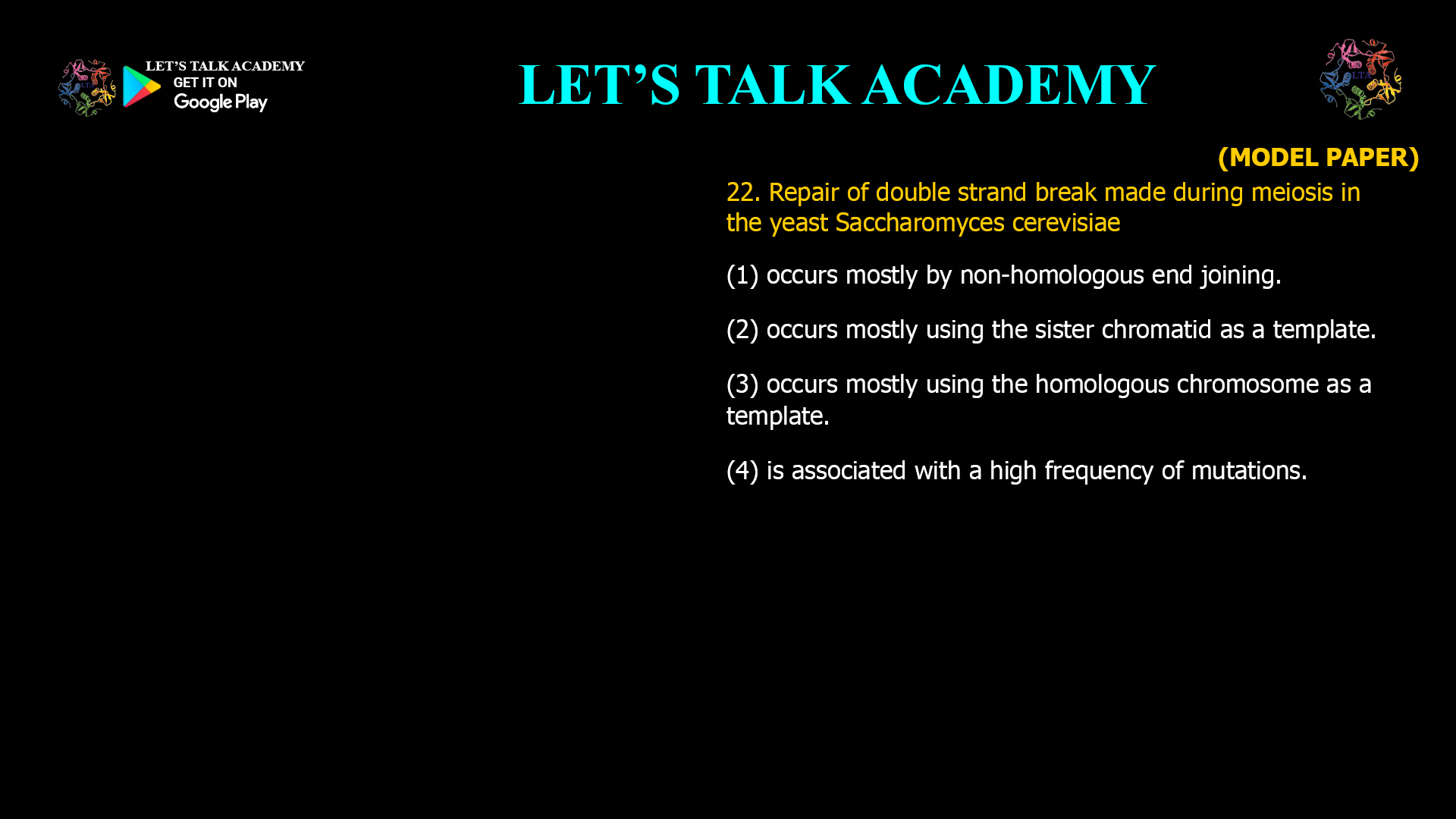- Repair of double strand break made during meiosis in the yeast Saccharomyces cerevisiae
(1) occurs mostly by non-homologous end joining.
(2) occurs mostly using the sister chromatid as a template.
(3) occurs mostly using the homologous chromosome as a template.
(4) is associated with a high frequency of mutations.Repair of Double-Strand Breaks During Meiosis in Saccharomyces cerevisiae: Homologous Chromosome as Template
Meiotic recombination is a vital process in sexually reproducing organisms, ensuring genetic diversity and proper chromosome segregation. In the yeast Saccharomyces cerevisiae, programmed double-strand breaks (DSBs) initiate meiotic recombination, which is repaired through highly regulated mechanisms.
How Are Meiotic DSBs Repaired in S. cerevisiae?
-
DSB Formation:
Meiotic DSBs are introduced by the Spo11 protein complex at specific hotspots on chromosomes. -
Template for Repair:
Unlike mitotic cells that often use sister chromatids for repair, meiotic DSBs in S. cerevisiae are predominantly repaired using the homologous chromosome (homologue) as the template rather than the sister chromatid. -
Purpose of Using Homologous Chromosome:
This interhomolog repair promotes genetic recombination (crossing over), which increases genetic diversity and ensures proper segregation of homologous chromosomes during meiosis I. -
Molecular Evidence:
Studies mapping DSB sites and recombination events (e.g., chromosome III) confirm that repair occurs via interaction with the homologue, not the sister chromatid.
Why Not Non-Homologous End Joining or Sister Chromatid?
-
Non-Homologous End Joining (NHEJ):
-
NHEJ is generally suppressed during meiosis to favor homologous recombination, which is more precise and essential for crossover formation.
-
-
Sister Chromatid as Template:
-
Although sister chromatids are identical and available post-replication, meiotic cells preferentially use the homologue to promote genetic diversity.
-
Is Meiotic DSB Repair Associated with High Mutation Frequency?
-
Meiotic recombination is a high-fidelity process, tightly regulated to minimize mutations.
-
While gene conversion and crossover events alter genetic combinations, they do not generally increase mutation rates.
-
Thus, meiotic DSB repair is not typically associated with a high frequency of mutations.
Summary of Options
Option Correctness in S. cerevisiae Meiotic DSB Repair (1) Non-homologous end joining No (2) Using sister chromatid as template No (3) Using homologous chromosome as template Yes (4) Associated with high frequency of mutations No
Correct Answer
(3) occurs mostly using the homologous chromosome as a template
Related Keywords for SEO Optimization
-
Meiotic double-strand break repair
-
Saccharomyces cerevisiae recombination
-
Homologous chromosome template
-
Spo11-mediated DSB formation
-
Meiotic crossover formation
-
Homologous recombination in meiosis
-
Genetic diversity in yeast
-
DNA repair during meiosis
-
Interhomolog recombination
-
Yeast meiotic recombination hotspots
Conclusion
In the yeast Saccharomyces cerevisiae, repair of meiotic double-strand breaks occurs mostly via homologous recombination using the homologous chromosome as the template. This mechanism is essential for generating genetic diversity and ensuring accurate chromosome segregation during meiosis. Non-homologous end joining and sister chromatid-based repair are not the primary pathways during meiosis, and the process is not associated with a high mutation frequency.
Correct answer: (3) occurs mostly using the homologous chromosome as a template
-




8 Comments
Komal Sharma
November 7, 2025In the yeast Saccharomyces cerevisiae, repair of meiotic double-strand breaks occurs mostly via homologous recombination using the homologous chromosome as the template.
Neelam Sharma
November 7, 2025occurs mostly using the homologous chromosome as a template
Divya rani
November 7, 2025Repair of ds break made during meiosis in the yeast occurs mostly using the homologous chromosome as a template. This mechanism is essential for generating genetic diversity and ensuring accurate chromosome segregation during meiosis. Non homologous end joining and sister chromatid base repair are not the primary pathways during me is and tge process ia not associated with a high mutation frequency.
Kirti Agarwal
November 8, 2025Occurs mostly using the homologous chromosome as a template
Anisha Beniwal
November 9, 2025occurs mostly using the homologous chromosome as a template
priti khandal
November 9, 2025option 3 rd is correct
Heena Mahlawat
November 9, 2025Option 3
Kajal
November 23, 2025Option 3